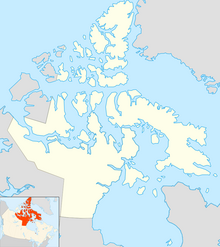
Eastern Air Lines Flight 66 was a regularly scheduled flight from New Orleans to New York City that crashed on June 24, 1975 while on approach to New York's John F. Kennedy International Airport, killing 113 of the 124 people on board. The crash was determined to be caused by wind shear caused by a microburst, but the failure of the airport and the flight crew to recognize the severe weather hazard was also a contributing factor.

Prince George Airport is an airport that serves Prince George, British Columbia, Canada, and the surrounding area. It is located just within the southern boundary of the city, 2.8 nautical miles southeast, and is run by the Prince George Airport Authority.

Lake Simcoe Regional Airport,, , is a registered aerodrome located almost midway between Barrie and Orillia, in the township of Oro-Medonte, Ontario, Canada, near Highway 11. The airport is operated by both municipalities. The airport has published instrument approaches.
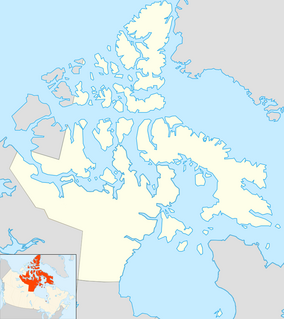
Iqaluit Airport serves Iqaluit, Nunavut, Canada and is located adjacent to the city. It is operated by the government of Nunavut. It hosts scheduled passenger service from Ottawa, Montreal, Rankin Inlet, and Kuujjuaq on carriers such as Canadian North, and from smaller communities throughout eastern Nunavut. It is also used as a forward operating base by the CF-18 Hornet. In 2011, the terminal handled more than 120,000 passengers.

St. John's International Airport is in Newfoundland and Labrador, Canada. It is an international airport located at the northern limits of St. John's, Newfoundland and Labrador that serves the St. John's metropolitan area and the Avalon Peninsula. The airport is part of the National Airports System, and is operated by St. John's International Airport Authority Inc.

Resolute Bay Airport is located at Resolute, Nunavut, Canada, and is operated by the government of Nunavut. It is one of the northernmost airfields in Canada to receive scheduled passenger airline service.

Buffalo Airways is a family-run airline based in Yellowknife, Northwest Territories, Canada, established in 1970. Buffalo Airways was launched by Bob Gauchie and later sold to one of his pilots, Joe McBryan. It operates charter passenger, charter cargo, firefighting, and fuel services, and formerly operated scheduled passenger service. Its main base is at Yellowknife Airport (CYZF). It has two other bases at Hay River/Merlyn Carter Airport (CYHY) and Red Deer Regional Airport (CYQF). The Red Deer base is the main storage and maintenance facility. The airline is also the subject of the History television reality series Ice Pilots NWT.

Canadian Forces Base Trenton, formerly RCAF Station Trenton, is a Canadian Forces base located within the city of Quinte West, Ontario. It is operated as an air force base by the Royal Canadian Air Force (RCAF) and is the hub for air transport operations in Canada and abroad. Its primary RCAF lodger unit is 8 Wing, commonly referred to as 8 Wing Trenton. CFB Trenton is Canada's largest Air Force base.

Ulukhaktok/Holman Airport, located at Ulukhaktok, Northwest Territories, Canada was fully opened in December 1978 with the start of the Community Aerodrome Radio Station (CARS). However, aircraft had been using the runway prior to that as construction was completed in the summer of 1978.

Edmonton City Centre Airport (ECCA), also called Blatchford Field as well as Edmonton Municipal Airport, was an airport within the city of Edmonton, in Alberta, Canada.
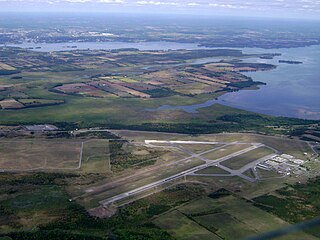
Trenton/Mountain View Airport,, is located 5.2 nautical miles southeast of Mountain View, Ontario, Canada.

North-Wright Airways is an airline based in Norman Wells, Northwest Territories, Canada. It operates commuter services to several communities in the Northwest Territories, and charter services. Its main base is Norman Wells Airport and they operate the Norman Wells Water Aerodrome.
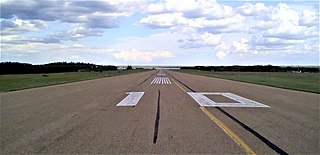
Edmonton/Cooking Lake Airport,, is a registered aerodrome located 15 kilometers east of Edmonton, Alberta, Canada on the west shore of Cooking Lake, north of the hamlet of South Cooking Lake, Alberta, Canada. Cooking Lake Airport is the largest of two public airports located within Strathcona County and currently serves 87 per cent of the County's public aeronautical traffic.

Jan Mayensfield is an aerodrome serving Olonkinbyen in Jan Mayen, Norway. Operated by the Norwegian Armed Forces, it serves the island's only population at the combined military and meteorological station. It has a 1,500-meter (4,921 ft) dirt runway numbered 06–24.

Air Canada Flight 646 was a flight from Toronto's Lester B. Pearson International Airport to Fredericton, New Brunswick, operated by Air Canada. On December 16, 1997, at 23:48 local time, the Canadair CRJ-100ER (CL-65) jet crashed after a failed go-around attempt in Fredericton. All passengers and crew survived, despite a 1-hour, 30-minute emergency response time and inadequate emergency training of the flight crew.

Sibu Airport is an airport located 23 km (14 mi) east south east of Sibu, a town in the state of Sarawak in Malaysia. In 2018, the airport handled 1,579,528 passengers on 20,869 flights and also handled 1,443 metric tonnes of cargo. The airport is the 11th busiest airport in Malaysia, and the 3rd busiest in Sarawak in terms of passengers handled.

Aérodrome de Jacmel was the sixth busiest airport in Haiti by passenger volume before the 2010 Haitian earthquake, near the city of Jacmel, on Haiti's south coast. The airport's timezone is GMT –5, and is in World Area Code region #238.
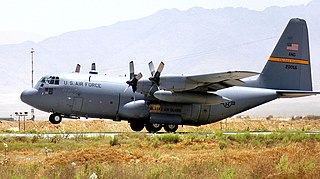
The 144th Airlift Squadron is a unit of the Alaska Air National Guard 176th Wing located at Joint Base Elmendorf-Richardson, Anchorage, Alaska. The 144th is equipped with the C-130H2 Hercules.

Kingston Airport, also known as Norman Rogers Airport, is an airport located 4.3 nautical miles west of the core of Kingston, Ontario, Canada.
